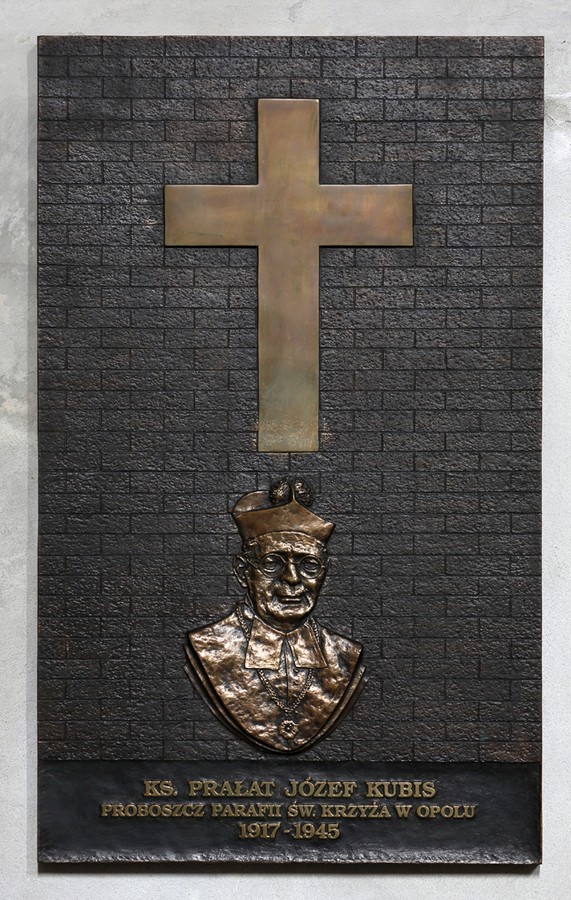PLAQUE COMMEMORATING PRIEST JÓZEF KUBIS
Six temples, three hospitals, as well as an old people’s home (with a psychiatric hospital for children and adults) were built in Opole and the nearby area. These sacral and secular buildings were built during the three decades of service Józef Kubis did as the cathedral parish priest. The plaque we are standing at, commemorates his name.
Priest Kubis was born in 1874 in Prószków, a town situated in the Opole Province near Namysłów. He studied in both Fryburg and Wrocław. He was the parish priest of the this Opole temple from 1917 to 1945. When priest Kubis arrived in Opole, the Parish of the Holy Cross served fifteen surrounding villages and had about 37 000 followers. Thus, it is not surprising that the church authorities made the decision to build more temples. Priest Kubis, who was entrusted with the task, turned out to be a wonderful organizer and performer of the given tasks.
Priest Kubis built the next churches in Luboszyce, on Mickiewicza square in Opole, in the Szczepanowice district, in nearby Sławieńcice, as well as in Gosławice and Półwieś districts. He expanded the Church of Saint Sebastian in Opole. It was his innovation and support that led Jezuits to build their Church of the Sacred Heart.
Priest Kubis exhibited high resourcefulness! To carry out and finance all the investments made, he involved his own parishioners in the construction works, and sold postcards and castings to collect money. He also received a compensation from the authorities for passing the Opole Franciscan Church to Evangelicals in 1820.
Priest Józef Kubis was the head of the Saint Wojciech Foundation, which was in charge of the city hospital situated in Colegium Maius and Collegium Minus, currently known as the University of Opole. Due to his efforts, the hospital expanded. Later, the great builder of churches in Opole began construction of a new hospital with surgical wards, where currently the Provincial Hospital on Katowicka Street is located. The foundation he was running also bought and renovated an old castle in nearby Prószków. There he founded an old people’s home for hospital workers and Franciscan Nuns as well as The Saint Joseph Unit with, a psychiatric hospital for children and adults. Priest Kubis donated all his savings to these causes.
During his service, organs were built in the Cathedral. The previous marble alter, dedicated to The Lady of Opole was changed to a new neo-Baroque one, which was brought over from Jelenia Góra. Due to priest Kubis’ efforts, the painting (famous for its mercy) was renovated. The parish priest of the collegiate church, fearful of war damage, replaced the original painting of the Lady of Opole with a copy he ordered earlier. The original was stored in Prószków.
Pope Prius XI, known as archbishop Achilles Ratti, Apostolic Nuncio, was a guest in Opole in 1920, and appointed priest Kubis the prelate. The Pope stayed here, at the vicarage of the Holy Cross parish, while holding a post as the High Church Commissioner from the plebiscite area of Upper Silesia and East Prussia. In 1930 priest Kubis celebrated Pope’s stay in Opole with a plaque, which was placed on the wall of the vicarage building.
On May 6th, 1945 Prelate Kubis died of a disease in Prószków - where he was buried. Undoubtedly, he was a remarkable priest who transformed the city and its rich diocese history.


 Polski
Polski Deutsch
Deutsch Český
Český